War of the Spark has been an unusual set for the Vorthos community. On the one hand, every card is dripping with flavor. We’ve gotten cards for fan-favorite legends we never expected to see print, and at least for my own part I’ve seen interest in the story from people who did not care at all before the cinematic trailer dropped. At this point it’s pretty safe to call WAR the greatest flavor set to date, and I don’t think it’s particularly close.
On the other hand, there’s still a week to go before the novel releases, and the last story that advanced the plot in any meaningful way was published back in August. (I mean no disrespect to Nicky Drayden; but while her writing was excellent, the content she was given counts as filler at best.)This leaves me in a bit of an odd spot. There’s flavor stuff everywhere at the moment, and the unique preview schedule has done a very good job of giving everyone access to the rough story beats that are going on. But there is no full narrative for me to dig into. While I certainly have suspicions about how things will go based on the cards we’ve seen so far, I don’t want to try to speculate an entire story arc from card art and flavor text.
Instead, I want to focus on new cycle of cards that mirrors one from the past. Back in Hour of Devastation, we got these cards to mark the Gatewatch’s first clash with the elder dragon:
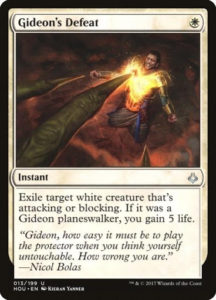
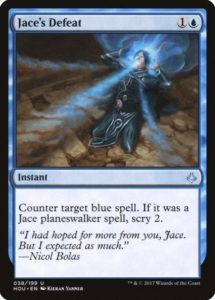
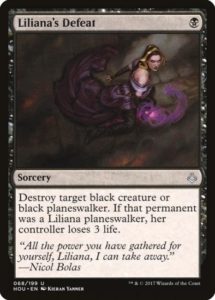
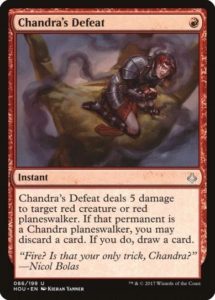
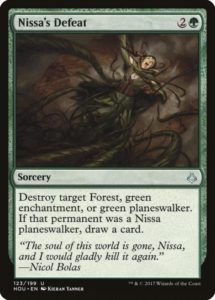
It didn’t go well.
I won’t go into the specifics of a two-year-old story right now; but Bolas went out of his way to humiliate the Gatewatch, taking each planeswalker on at their own game and crushing them with barely a fraction of his power. It was the moment that definitively set up the conflict playing out now and officially turned Bolas into the end boss of the multiverse. To put it mildly, Bolas’s gloating in the flavor text here is mild compared to the actual story.
Now things have come full circle, and the cards are telling a different story.
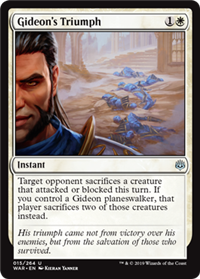
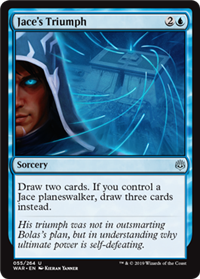
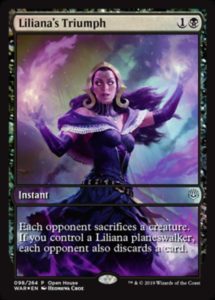
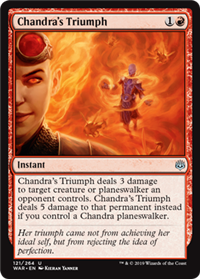
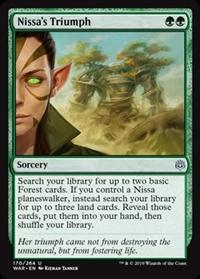
We don’t have the full story behind these cards, and the choice to reveal them a few days before cards such as The Elderspell indicates that the cycle of triumphs aren’t the finale of the story. Nevertheless they stand as a fascinating counterpoint to their mirrors from two years ago.
I’ve seen a number of people speculating that these cards depict the Gatewatch turning to the dark evil, embracing darker natures in order to defeat Bolas. I see where this interpretation is coming from—the shared layout of the art lends the planeswalkers a menacing air and the trail of corpses behind Gideon doesn’t exactly help matters. But I would be very surprised if that’s what actually happens. The key in my mind is the flavor text, which explicitly spells out what each triumph means on a personal level.
Gideon has been defined by survivor’s guilt ever since he got his friends killed back on Theros, and he achieves triumph by saving innocents. Presumably from the horde of eternals featured in the card’s art.
Jace is playing the mental game as always. While his triumph is framed as the moment where he finds a crucial weakness in Bolas’s plan, the text makes it clear that he isn’t outthinking the dragon. Instead, Jace finds a systemic problem with Bolas’s way of thinking that leaves fatal flaws in everything he does. This addresses what could easily be a sticking point for many people: the fact that a ragtag bunch of mortals could ever hope to touch the plans of an immortal dragon god. I said this last summer, but for all his power Bolas is an incredibly flawed character.
Liliana is the odd woman out at the moment. We know her triumph exists and is getting a card. But so far only the promo version has been revealed, devoid of both flavor text and the explicit art clues that the others hold. More on her later.
Chandra’s entire life has been wrapped up in self-doubt and failure. Inventor, smuggler, monk, artist—her past is littered with failed paths and careers that ended in flames. Her triumph shows her overcominging one of her biggest demons in the form of the consulate’s Dovin Baan. But in rejecting the idea of perfection that he embodies, I think she’s also overcoming her own need to be more than who she is.
Nissa has always been a champion of nature, but her arc has teetered back and forth between avenger of the wilds and defender of life. The moment showcased on Nissa’s triumph seems to be when she animates the world-tree of Vitu-Ghazi. With the flavor text it seems that she’s dedicated her efforts in the war to ensuring Ravnica itself survives. Given the desolate wasteland she saw on Amonkhet, that’s no small feat.
The key here is that each triumph is not just a pivotal moment in the war against Bolas, but also moment of personal growth for the planeswalkers in question. What a fantastic degree of storytelling to find in a card game! Perhaps we can use this to extrapolate the flavor of Liliana’s Triumph? (Yes, I know the story got spoiled, but I’ve managed to avoid any unwanted information.)
Despite the aloof façade she puts up, Liliana has a lot of baggage. Haunted by her brother’s death, every decision that she’s made has been to fend off the grasping reach of death. This manifested in two main ways: a dangerous obsession with power that sometimes borders on megalomania, and her pervasive fear of death.
Her origin story drives home the point that Liliana easily could’ve sought immortality through lichdom when the mending stole her godhood. That’s what any other necromancer of her caliber would have done. But for all her power Liliana can’t bear the thought of surrendering to death. She needs to be the master of it. Untouched, superior.
From here it’s easy to make a leap and assume that Liliana’s triumph will depict her rebuilding from the moment we saw in the cinematic trailer, ascending beyond death to become our first zombie/lich planeswalker. But that doesn’t feel right to me. Death might be Liliana’s biggest fear, but it isn’t her biggest hurdle. Besides, it would feel wrong to tell four stories that seem to be about unabashedly positive personal growth and round out the cycle with something that twisted. Plus . . . well . . . Liliana’s triumph is a removal spell, not a reanimation piece.
There has always been a very odd tension at the core of Liliana’s character. She is fundamentally obsessed with power and control, to the extent that she has to convince herself that the rest of the Gatewatch are “better zombies” that she can bend to her will; and yet the two most defining moments of her life revolved around her bowing to outside forces.
Her spark ignited from the horror she felt after accidentally lich-ifying her brother Josu. But for all her recklessness in casting that spell, it was given to her under false pretenses by the raven man, a mysterious psychic figure whose possession she has never been able to escape. And of course her contract with the four demons was the ultimate surrender, a choice that ruled her entire subsequent life.
We know that she hated being beholden to the demons, and she murdered all four of them. But all her efforts got her was an even harsher overlord. Despite everything she’s kept trying to game the system, hoping to cheat her way out with her life, her freedom, and her power all intact. But at every turn she’s only dragged herself deeper into a deadly morass.
My guess is that her triumph will come when Liliana realizes that she can’t afford to keep sacrificing for power. She’s seen precisely where that path leads. After a year around the Gatewatch I think she’s at the point where, just maybe, she can see that she needs help. Maybe something along the lines of:
Her triumph was not in conquering death, but in standing against those who would command her.
As for the artwork? This is a kill spell, and there’s one very important dragon that needs killing. That might seem odd for a diabolic edict effect, but I’ve spoken before about how Bolas has no real allies. Since the eternals follow Liliana instead of Bolas, he’s literally a team of one at the moment. This might be a bit of a stretch, but I wouldn’t be surprised to see Liliana’s Triumph as the final card fully revealed from the set.
Levi Byrne has been with the game since Worldwake and has a rabid love for fantasy writing that goes back decades. Despite some forays into Legacy he plays Commander almost exclusively, and has a love for the crazy plays and huge games that make Magic what it is. He was the go-to advisor of his playgroup on deck construction for more than five years before joining Dear Azami.

